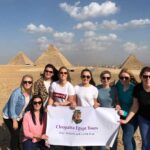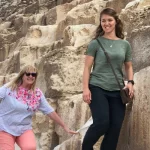Mortuary Temple of Hatshepsut
Against its stark mountainous backdrop, the partly rock-hewn Mortuary Temple of Hatshepsut at Deir al-Bahri is a breathtaking sight. It was designed by Queen Hatshepsut’s architect Senenmut in the 18th Dynasty and is an extraordinary monument which rises from the desert plain in a series of imposing terraces.
The temple was damaged by Ramses II and his successors, and Christians later turned it into a monastery (hence the name Deir al-Bahri, which means “Northern Monastery”). However, the ongoing excavation of the site continues to reveal much exquisite decoration. Adjacent to the main temple are the ruins of the much older Temple of Montuhotep II, the ruler of the 11th Dynasty who managed to unite Egypt, and the 18th-Dynasty Temple of Tuthmosis III.
Hatshepsut Temple Features.
Temple of Montuhotep II
The prototype for Hatshepsut’s Temple, the older Temple of Montuhotep II now lies in ruins.
RECONSTRUCTION OF THE TEMPLES AT DEIR AL-BAHRI
This reconstruction shows the Temples of Montuhotep II, Tuthmosis III, and Hatshepsut as they would have looked during the reign of Tuthmosis III in the 18th Dynasty. Partly rock-cut and partly free-standing, the three temples are set into a natural amphitheater and are given added majesty by the dramatic cliffs behind them.
Chapel of Hathor
This chapel is noted for its Hathor-headed columns. The walls have retained much original coloring, including this relief of the ankh and djed pillar, symbols of life and stability.
Statues of Hatshepsut
The columns of the portico around the upper terrace were decorated with Osiride statues of Hatshepsut, characteristically represented as a male king with a beard. Although many statues were destroyed by later pharaohs, several have recently been reconstructed from their fragments.
Chapel of Anubis
sanctuary This chapel contains brightly colored murals, including relief of Tuthmosis III making offerings to the sun god Ra-Harakhty.
Birth Colonnade
Scenes along the Birth Colonnade portray the divine birth of Hatshepsut, designed to legitimize the queen’s claim to the throne. On the right, the young queen is shown in the arms of the goddess Neith.
Reliefs of Punt Expedition
Stunning reliefs relate Hatshepsut’s journey to the Land of Punt (Somalia). The king of Punt is seen here with his wife Ati (left), who is depicted suffering from obesity.
Book your Travel Package now to know more about Egypt history.





